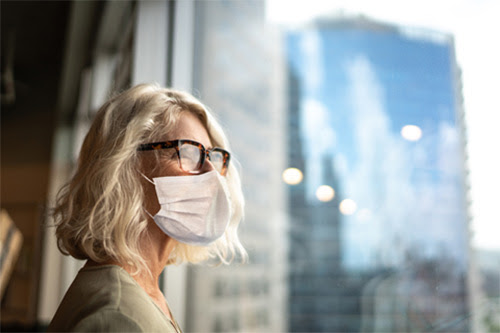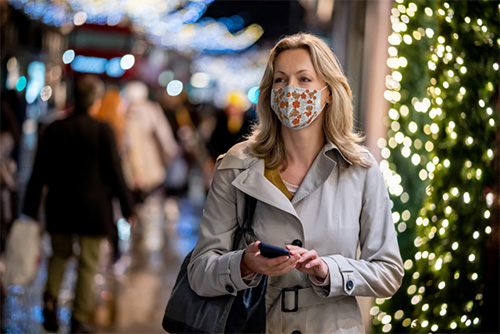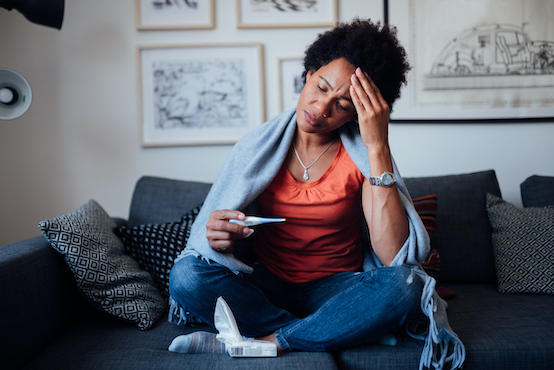By WHN Editors
New cases of Covid-19 in the US have fallen by more than a third in the past month. Could this finally be a sign that we’re pulling out of the Covid woods?
Unfortunately, not so fast.

According to a recent New York Times analysis, since Covid began spreading in late 2019, cases have followed a pattern, typically surging for about two months and then declining for about two months. We appear to be in the latest two month downswing. If this pattern holds, the virus could be ready to make another move as early as November. Whether this is a further downturn or — following the pattern — another upswing remains to be determined.
So, how do we anticipate what’s to come? The only real way to prepare is to be ready for both a best case Covid scenario and a worst case Covid scenario too.
Best case Covid scenario — reasonable precautions are enough
At this time last year we were grappling with the grim forecast of a large and deadly spike in cases throughout the fall and winter months. This year is different. While the model is still taking shape, key factors — higher vaccination numbers, booster shots, continued ease of testing, and more people with immunity from having had the virus — may be enough to head off a repeat of last winter’s surge.
In a perfect world, everyone in your immediate social circles (including you!) has been vaccinated or has immunity from already having had the virus — or both. If you are in this situation, getting through the months ahead could be as simple as taking the basic precautions of wearing a mask, continuing to social distance, taking care of your immune system, and practicing good hand washing and other hygiene habits.
Of course, even in a best case Covid scenario, there will be those who grumble about what could go wrong. Doom-mongering complaints usually focus on lower than hoped for vaccination rates in many parts of the country. What this outlook gets wrong is not factoring in people who have recovered from the virus. While the research is still controversial, natural immunity conferred from contracting and recovering from the virus may provide as much protection as the vaccine.
It’s best for everyone — whether or not they’ve ever been infected — to get the vaccine. However, there is growing acceptance of natural immunity’s benefits. For example, much of Europe and Israel have already adopted policies that for entry to concerts, restaurants and other public indoor gathering places, people are required to provide one of three proofs: a vaccine passport, negative PCR test, or proof that the person has recovered from Covid. In Germany, this policy has even been given the catchy nickname of the 3Gs. In German: “Geimpft, Genesen oder Getestet”, meaning “vaccinated, recovered or tested.” Got one of the 3Gs? Then you are good to go. In the US, could adopting similar guidelines be the solution to the controversy of how to make public indoor spaces safer for all this winter? It’s a conversation worth having.
Worst case scenario — protecting yourself should cases spike
Let’s stay focused on these groups of vaccinated and natural immunity populations in setting up our worst case scenario.
States such as Connecticut, Massachusetts, Vermont, New York and Maine have some of the highest vaccination rates in the country — hovering somewhere near 70%. If you add up people who have received the vaccine and people who have contracted and recovered from the virus, it totals approximately 80-85% of the population in many of these states.
So what does that leave us with? About 15-20% of people who are not vaccinated and have not had Covid. It’s this group that can make all the difference in what unfolds this fall and winter.
Here’s why. There are almost 70,000 ICU beds in the US. As of the end of August, approximately 3/4 of these beds were full; only about 18,000 beds are empty right now. It won’t take a very big surge to fill those remaining beds — and the risk factors are there for a surge: people in northern states are starting to spend more time indoors where Sars-CoV-2 is highly efficient at spreading. Delta is still here, as contagious as chicken pox. There may be a new variant in the offing that comes with its own complications. A bad flu season this year could add tremendously to the burden on hospitals.
Any and all of these factors coming together to even slightly raise the number of serious infections could lead to calamity. Think about it. Nationwide, you have about 50 million people, including children, who are not vaccinated. If significant Covid cases break out, or we have a really bad flu season and only moderate Covid cases, either of these scenarios could be enough to overwhelm the medical system.
What’s the state of your immunity?
We’ve compared Covid infections in the past to a race between your immune system and the virus. If your immune system wins, the virus loses and your symptoms will be mild. If the virus wins, you might not be so lucky.
The problem for many of us is that we’re unknowingly part of a silent epidemic of suppressed immune function. Immunity is a tricky thing to pin down and we don’t really know how well our bodies will respond — until they need to.
If you’re still hesitant about the vaccine, you owe it to yourself to see if you have one of the many health conditions and habits that lower immunity. Just to give you a quick summary, this includes obesity, diabetes, heart disease, many prescription medications, prior cancer treatment, having an autoimmune disease, plus age. All of these things impair immune function and affect literally millions of people.
Another question is — what kind of Covid risks do you have in your daily life? Are you a frontline worker? Do you have unvaxxed kids? Do you want to go to concerts and indoor restaurants? Do you not like wearing masks?
It’s not too late to get vaccinated. If you are already vaccinated, knowing your immunity risk factors can help you make a decision about getting a booster shot. More people winning the race against the virus means fewer people ending up in the hospital.
Riding out the virus at home
If we do end up in a worst case scenario and our hospitals jam up, should you contract Covid, you may need to be prepared to ride out a mild to moderate case of virus at home — and you’ll want to know what steps to take.
Before you do anything else, you need to be in contact with a doctor who can give you clear guidelines on when it’s a good idea to stay home and when it’s important to go to the hospital. Other steps to take:
- Isolate yourself away from other family members.
- Use a pulse oximeter to measure oxygen levels (oxygen saturation) in your blood. An oximeter can be a helpful tool for catching low oxygen levels early. The Chicago Tribune has a good article comparing different models.
- Drink ample fluids to help thin mucus secretions and support functioning of all organs.
- Rest. This is a big one. When you’re sick and exhausted, it sets the stage for opportunistic bacteria like pneumonia to invade. Pneumococcal bacteria is everywhere, including around the home (it’s not just in hospitals). Being stressed out and tired dampens immunity, letting your guard down. Do your best to be a good patient and prioritize rest.
Why a good bet this fall is still Swiss cheese
We’ve written before about the “Swiss cheese” model as a good way to think about how to stay safe from Covid. Each slice of Swiss cheese is a method of protection — from wearing a mask to social distancing to getting vaccinated to getting a booster. The slices all have holes in them, just like no method offers 100% certainty that you won’t contract Covid. However, when layered together, these holes start to close up. Layered protection gives us the best chance for turning a worst case scenario into a best case outcome.
Are you willing to do your part in steering the months ahead in the direction we all so desperately want? It starts with understanding the current state of your immune health and then being part of the solution.









